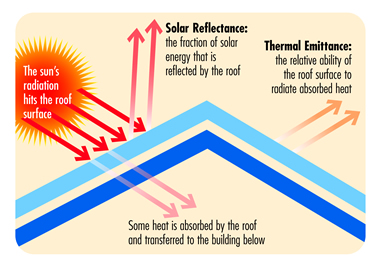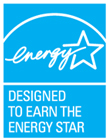 When one starts talking about roofs you will quickly run into a whole bunch of jargon; hot roof’s, cool roof’s, vented, unvented, green, flat, hybrid & the list goes on & on & on. Needless to say this can & does cause quite a bit of confusion especially when regional differences in naming conventions pop up, along with a plethora of marketing terms.
When one starts talking about roofs you will quickly run into a whole bunch of jargon; hot roof’s, cool roof’s, vented, unvented, green, flat, hybrid & the list goes on & on & on. Needless to say this can & does cause quite a bit of confusion especially when regional differences in naming conventions pop up, along with a plethora of marketing terms.
What is a Cool Roof?
 A cool roof is one that uses special materials or coatings to reflect the heat away from the roof surface. The most common type out there is where they apply a special white paint over a flat roof to reflect the heat away. As these roofs are white, many simply associate or assume that a cool roof has to be white &/or painted. The simple truth of the matter is that there are numerous colors & materials one can choose from which include tile, shakes, metal, & shingles. (Cool Roof Rating Council – tested products search)
A cool roof is one that uses special materials or coatings to reflect the heat away from the roof surface. The most common type out there is where they apply a special white paint over a flat roof to reflect the heat away. As these roofs are white, many simply associate or assume that a cool roof has to be white &/or painted. The simple truth of the matter is that there are numerous colors & materials one can choose from which include tile, shakes, metal, & shingles. (Cool Roof Rating Council – tested products search)
There is one other factor to consider & it is called emittance (not emissivity) or how quickly a product will allow any heat that is absorbed to be passed on. During the summer, most of this will be directed into the roof sheathing during the day, while at night it will be reversed and released back into space. When you combine both the reflectance with the emittance you get what is called a SRI or Solar Reflectance Index. The higher the SRI, the lower the roof temperature will be. (LBL SRI Calculator)
Climate Zones, the Future & Shelter in Place:
With the exception of an arctic climate, this can work well in all of them. The biggest reason many don’t even consider using them is that house designs & modeling work are designed looking back at averages and not what the past has held, or is liable to happen during the life of the building. As a quick side example, this year in the Midwest conditions were eerily similar to the Dust Bowl. Fortunately we did not have “Dust Bowl 2” as many of the past farming mistakes have long since been changed.
 That sounds nice, but I…Live in a heating dominant climate & I need that heat during the winter… Well I hate to break this to you, but if you are actually gaining any heat during the winter that way (highly unlikely as it is probably more psychological); you have some major issues like a complete lack of insulation. Not only is the angle of the earth relative to the sun impacting how much heat is delivered, but any heat gained is quickly radiated back out to space due to physics & winter time stack effect. That sounds nice, but I…Live in a heating dominant climate & I need that heat during the winter… Well I hate to break this to you, but if you are actually gaining any heat during the winter that way (highly unlikely as it is probably more psychological); you have some major issues like a complete lack of insulation. Not only is the angle of the earth relative to the sun impacting how much heat is delivered, but any heat gained is quickly radiated back out to space due to physics & winter time stack effect.
Have all these shade trees… I love passive measures but storms happen, fires happen, insurance companies happen & in an instant those lovely shade trees can be gone. |
It never seems to fail that if any sort of heat wave happens the news starts filling up with news of deaths & hospitalizations. Lord forbid if the heat wave knocks out the electricity which so many depend on to help keep them cool. Let’s be brutally honest, sure heating ones home to prevent freezing is important, but so is preventing ones house from turning into a broiler. Yes Vermont hit 97° & the Midwest can get as hot as or hotter than Death Valley as we found out this year. Guess what, it will happen again as history has shown & as many that believe in global warning predict.
Improve Efficiency:
Whether your ducts are located in conditioned space, the attic or elsewhere the efficiency of the system will generally be improved as you do not have as much heat entering the building. It helps to remember that insulation is great at keeping the heat inside a building which is its main purpose. During the summer it also helps to keep the heat out but that only lasts so long. Pretty soon the insulation will end up as the same temperature as the outside conditions or in the case of your attic the temperature in there.
Durability:
All certified cool roofing materials have to be tested & have the same or better durability specs as similar products. In most cases the “cool roofing” products are rated for lifetime use. The other major factor to consider is the sheathing & roofing material temperature, especially as it relates to shingles where they can easily get to a 150° which starts to degrade them.
Maintenance:
You may have noticed above that there is a 3 year value with a reduced reflectance value. That is simply because roofs do get dirty which in this case can reduce their effectiveness. In some places algae growth is an issue which some manufacturers deal with by incorporating sacrificial zinc or copper strips to help kill the algae when it rains. Other manufacturers are working on self-cleaning tiles & materials to eliminate this issue. Of course if all else fails there are companies that do this professionally.
The best option?
Metal roofing & concrete tiles are the top two options for a sloped roof as they not only have higher SRI numbers but will last a very long time. Specialized roof coatings do have higher SRI numbers but need to be redone every so often. Asphalt products are dead last but if one is stuck with an HOA mandating shingles & you have a hot cathedral ceiling, these are better than just regular shingles.

